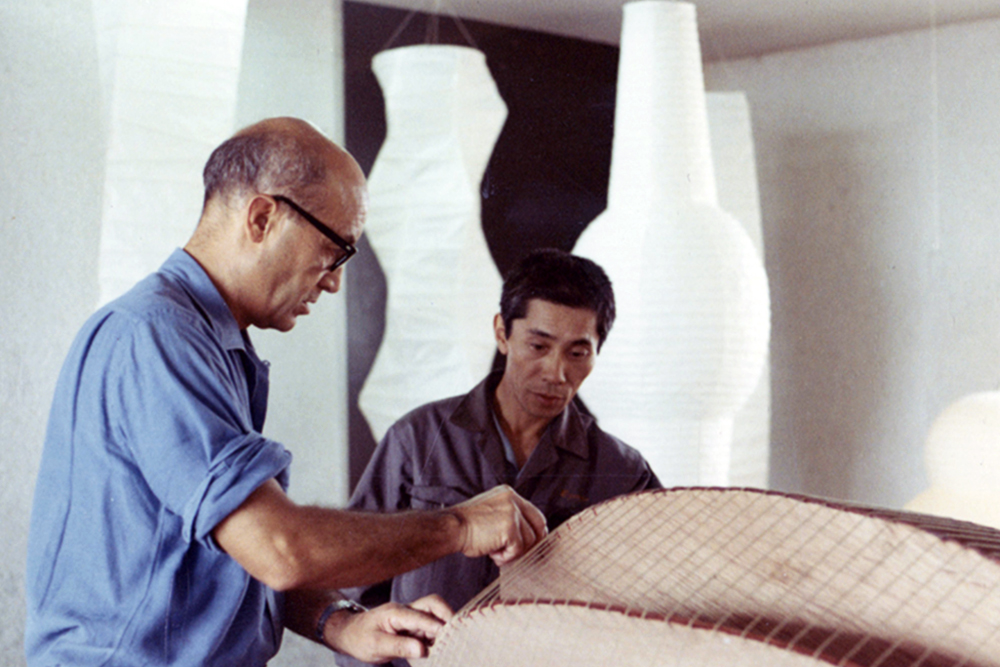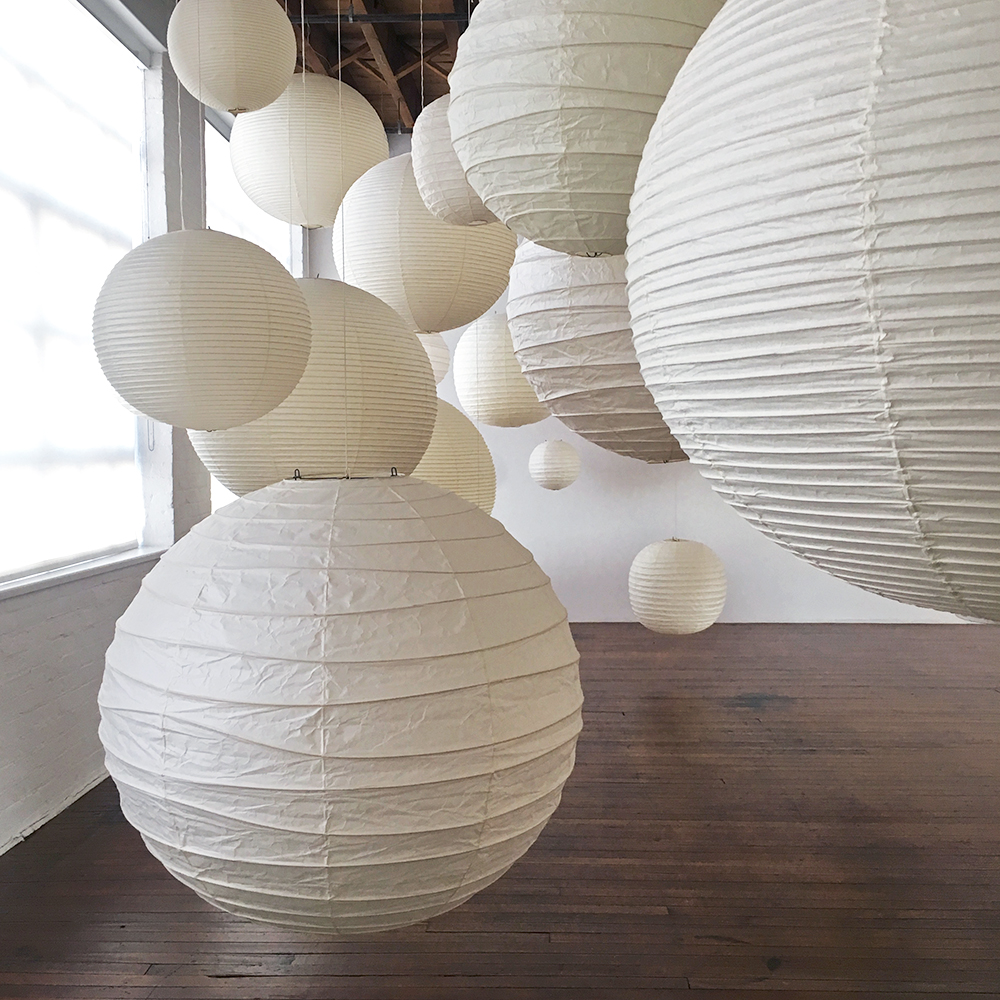
Isamu Noguchi. Ceiling LAMP, model H.
“Everything is sculpture” once remarked sculptor extraordinaire Isamu Noguchi, whose unique eye redefined the artform and all its possibilities, even creating shapes through light. “In a world of walls, Isamu Noguchi carved thresholds,” notes Zack Hatfield in Bomb magazine in honour of the 2017 retrospective at the Noguchi Museum. “Portals, gates, voids, and totems perforate the work of the late Japanese-American sculptor.”
In 1985, three years before his death, aged 84, Noguchi founded his eponymous museum in Long Island City, Queens, New York, to display what he considered “representative examples of his life’s work”. The Noguchi Museum shares its neighbourhood with other leading cultural establishments such as the Socrates Sculpture Park, the Museum of Moving Image and MoMA PS1. And not only does the 27,000-square-foot complex house the largest collection of Noguchi’s works, but, fittingly, the museum itself is considered one the artist’s finest accomplishments. Developed around a 1920s industrial building, a pair of exhibition floors give way to indoor-outdoor galleries and an open-air sculpture garden. The museum also hosts an array of educational programs and workshops, its permanent installations regularly joined by temporary exhibits that offer “a rich, contextualised view of Noguchi’s work and his enduring influence on contemporary culture”.
“He could be a Cubist. He could be a Surrealist. He could be a Minimalist,” writes Mark Stevens in New York Magazine. “He could take from Brancusi here, Giacometti there. He could tend Zen’s garden. Noguchi’s art is the mongrel creation of a mongrel century, yet it does not seem awkwardly pieced together.”
For a time in the late 1920s, Noguchi actually served as a studio assistant for Brancusi, the ‘godfather of modern sculpture’. Noguchi’s artistic path was almost inevitable, born in California in 1904 to a Japanese poet father and an American mother who was a writer. He spent some of his childhood in Japan before moving back to the USA where he studied medicine at Columbia University, though, in search of a creative outlet, simultaneously took classes at the Leonardo da Vinci Art School. The pull of art soon become too great and Noguchi disposed of his dream of becoming a doctor and headed to Paris in 1927. It was there that he met Brancusi.

Isamu Noguchi working on Akari in Japan, 1968.
“Sometimes I feel as though I’m part of this world today, sometimes I feel that I belong in history, or prehistory, or that there is no such thing as time.”
– Isamu Noguchi
Noguchi spent the 1930s between the USA, Europe and Asia—where he studied calligraphy in China and pottery making in Japan. Back in New York the artist began designing furniture, and even playgrounds, and struck up what would be a two-decade working relationship with legendary dance choreographer Martha Graham, designing her sets. “The works he created for my ballets brought to me a new vision,” she remarked, following his passing, “a new world of space and the utilisation of space. Isamu, as I do, always looked forward and not to the past.”
“They both were fascinated with myths and iconic figures and history,” Janet Eilber, artistic director of the Martha Graham Company tells the LA Times. “And they were both seeking the stripped-down essence of shape that evoked the shock of recognition.”
Noguchi was also decent. Following the outbreak of the second world war, he became a political activist, voluntarily spending more than half-a-year at a Japanese-American internment camp with the intention of understanding the detainees’ plight and designing better living quarters for them.
It was during the 1950s that Noguchi developed what was to become among his most loved work, akari (“light as illumination” in Japanese), riffing on Japan’s iconic ancient paper lanterns. Each one was crafted using traditional materials like bamboo and washi paper, but given a decidedly contemporary twist, designed to interact with lamp bases and each other in alternate ways. Some hang from the ceiling, others rest on bamboo posts, mount the wall or balance precariously on legs.

The Akari cloud piece at the Sculpture by Other Means exhibition.
“When Noguchi was alive, akari was a living, breathing, changing thing,” Dakin Hart, senior curator at the Noguchi Museum, tells Artsy. “But when he died, all the innovation stopped.”
The design continues to be mimicked around the world today in stores such as Bloomingdales and Ikea.
Much of Noguchi’s later sculptures were carved from stone, a material he described as “the fundament of the earth, of the universe”. Carving it, he believed, was “a process of listening”.
Noguchi’s notable public works include the enormous, gravity-defying ‘Red Cube’ in New York that balances on one corner and rises to 24 feet, and the 102-foot tall stainless steel ‘Bolt of Lightning’ near Philadelphia’s Benjamin Franklin Bridge. In 1986 he was selected to represent the USA at the Venice Biennale, his exhibit incorporating both sculpture and lamps.
“In his mature art, Noguchi united mankind with nature, East with West,” says Stevens, “becoming one of the few artists of the twentieth century able to make optimistic art that was not ostrich-headed.”
Following Noguchi’s death, retired director of the of the Solomon R. Guggenheim Museum, Thomas Messer, told The New York Times that Noguchi “lived with old values, which, in his hands, pointed in the exemplary fashion toward the new.” The artist, he added, simply “stood for perfection”.
Words — Jamie Christian Desplaces






